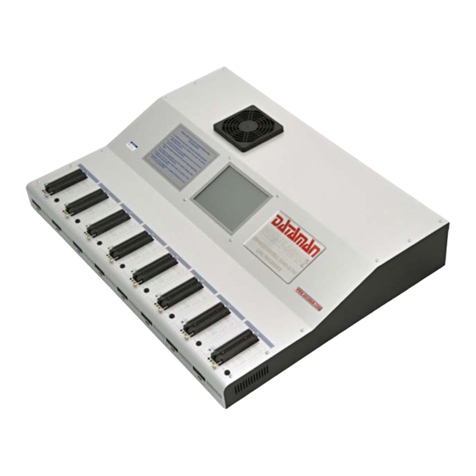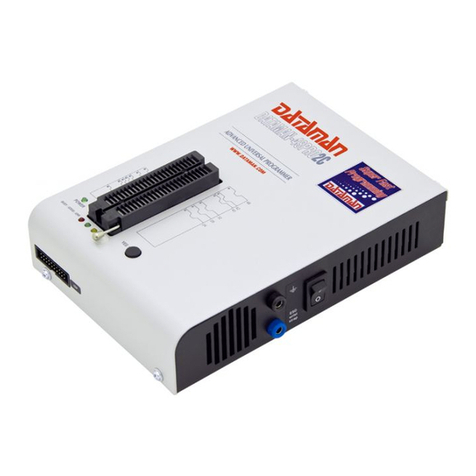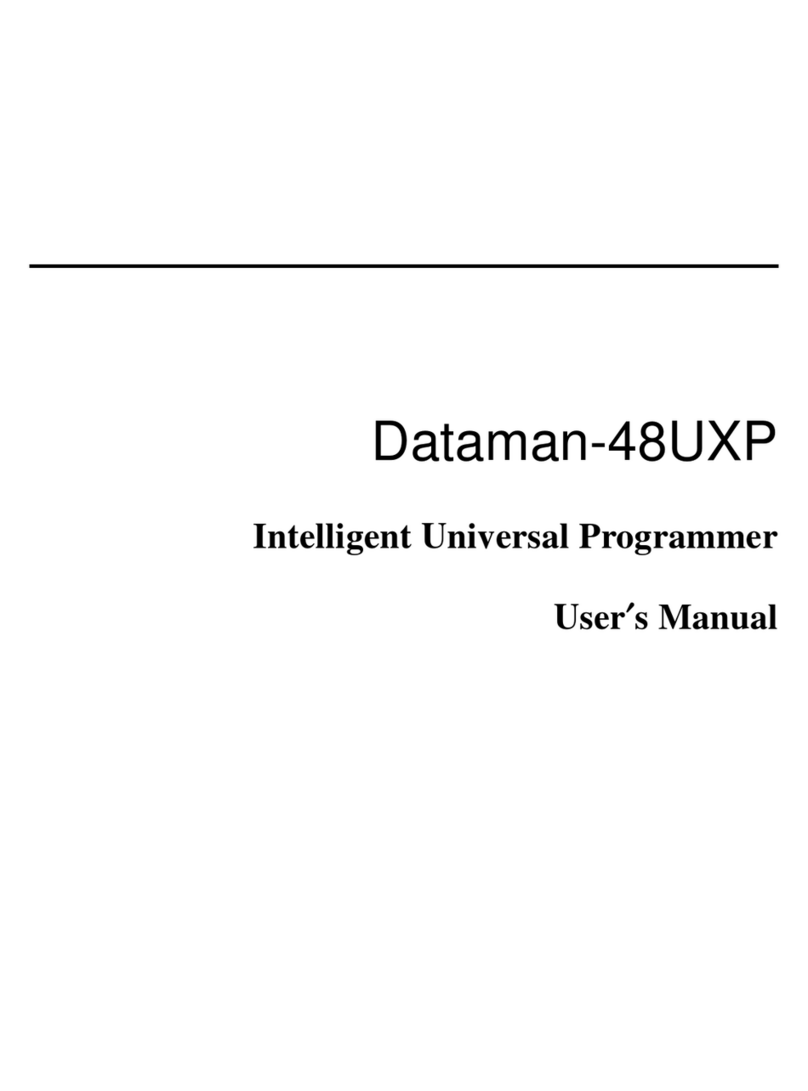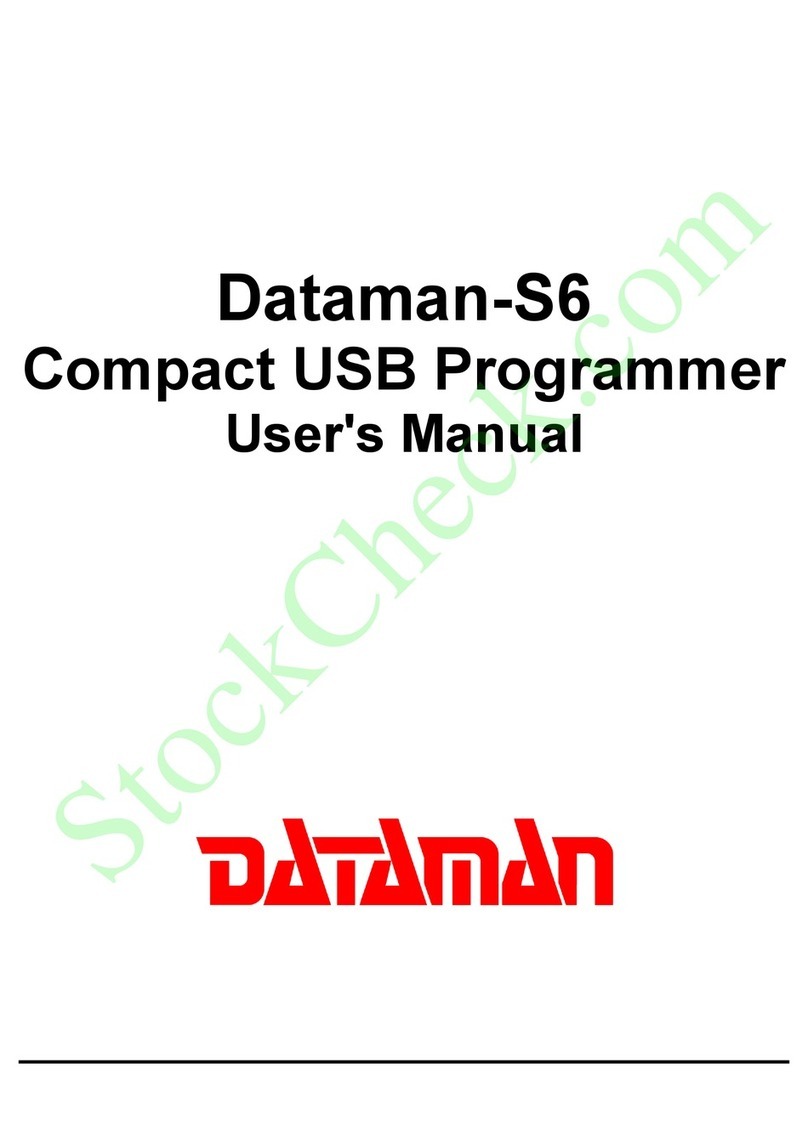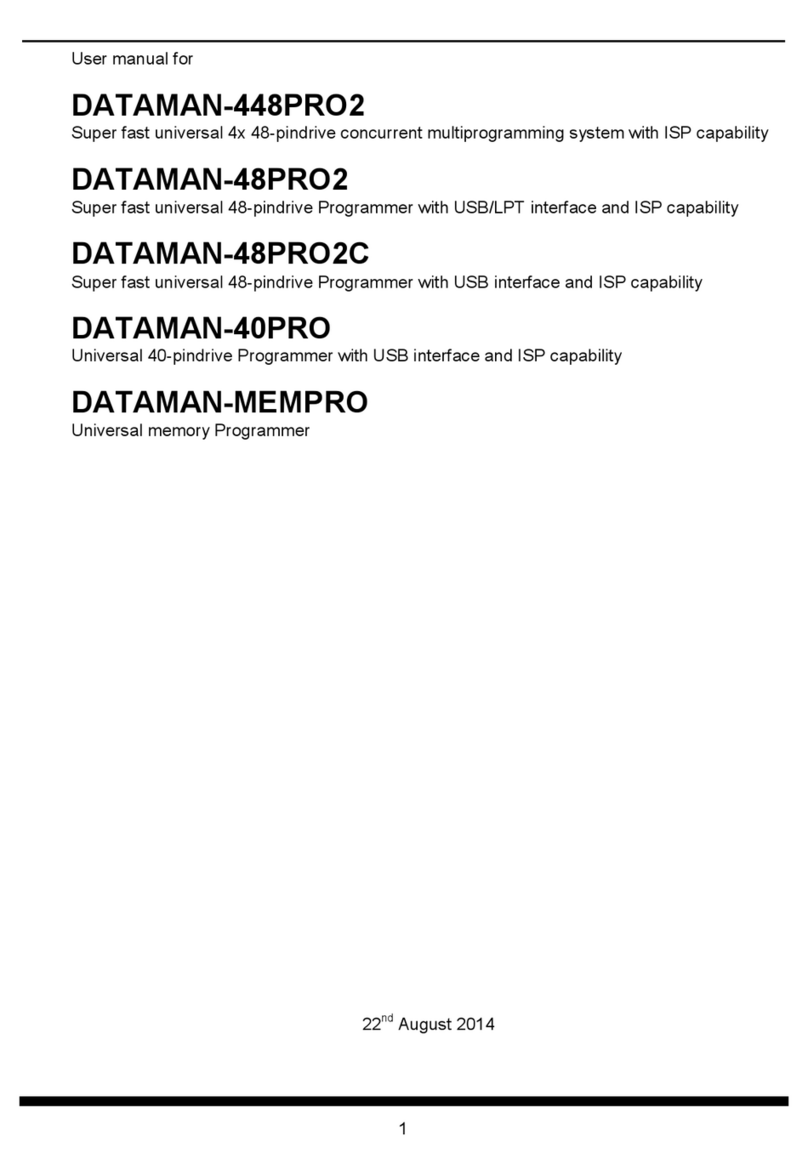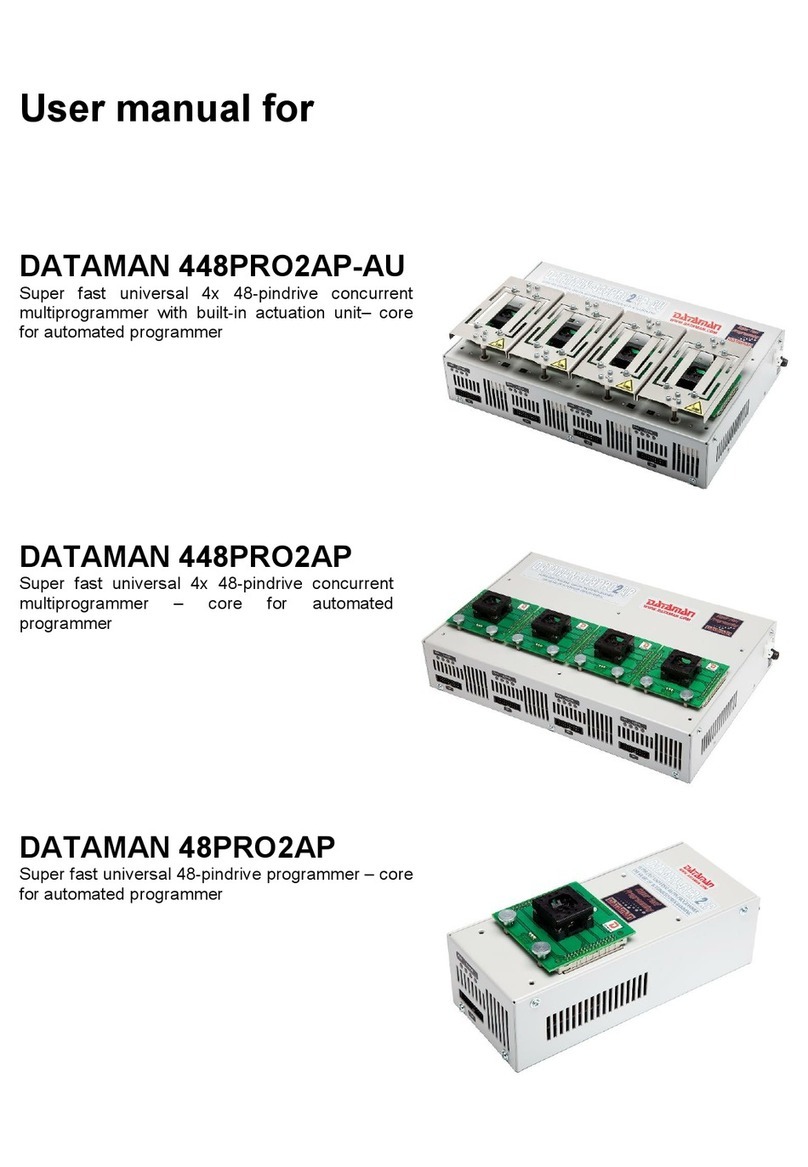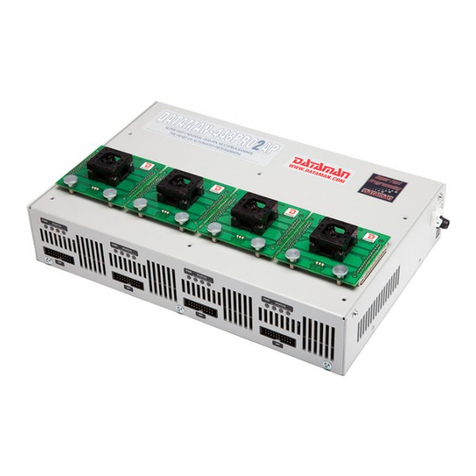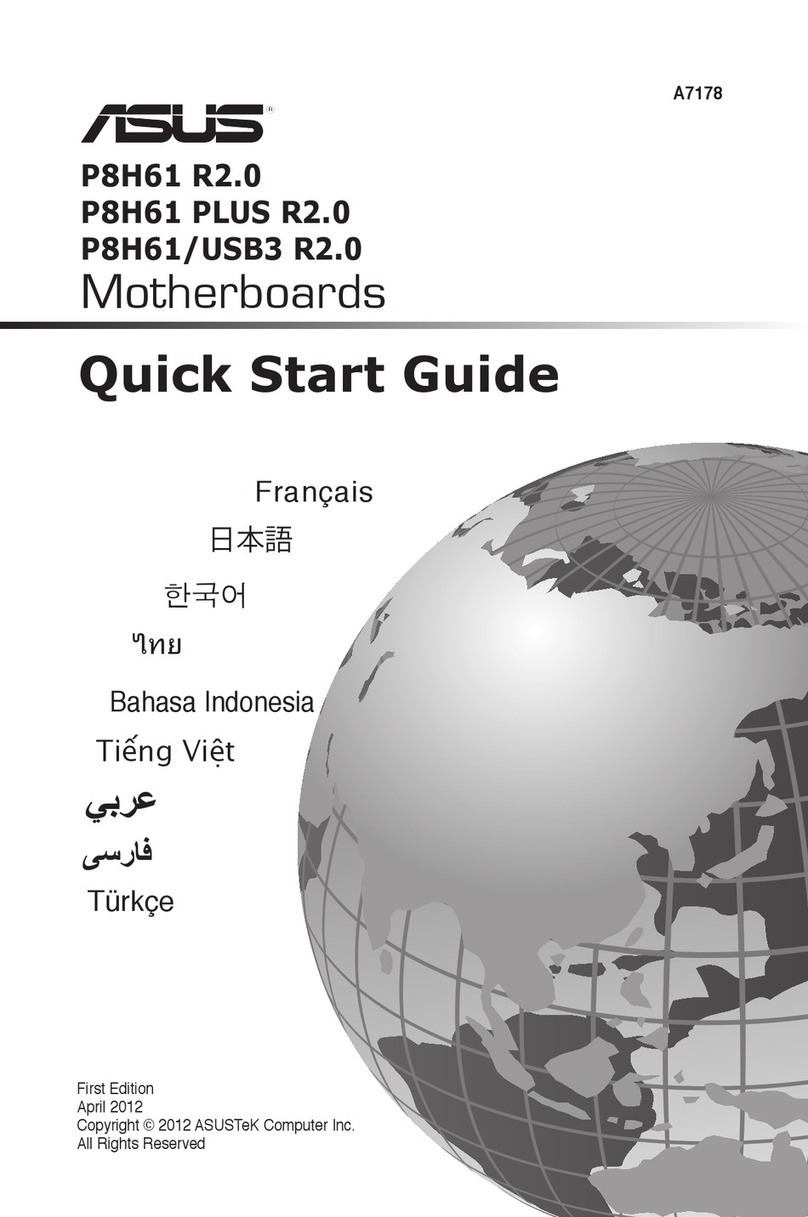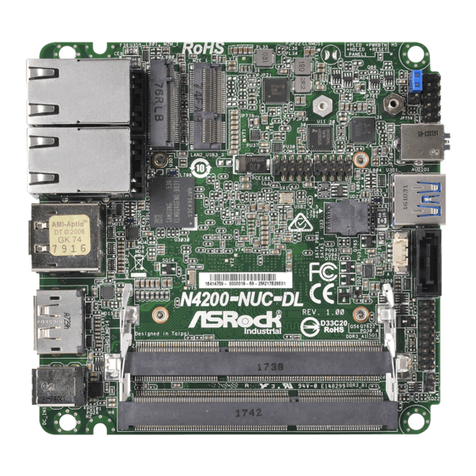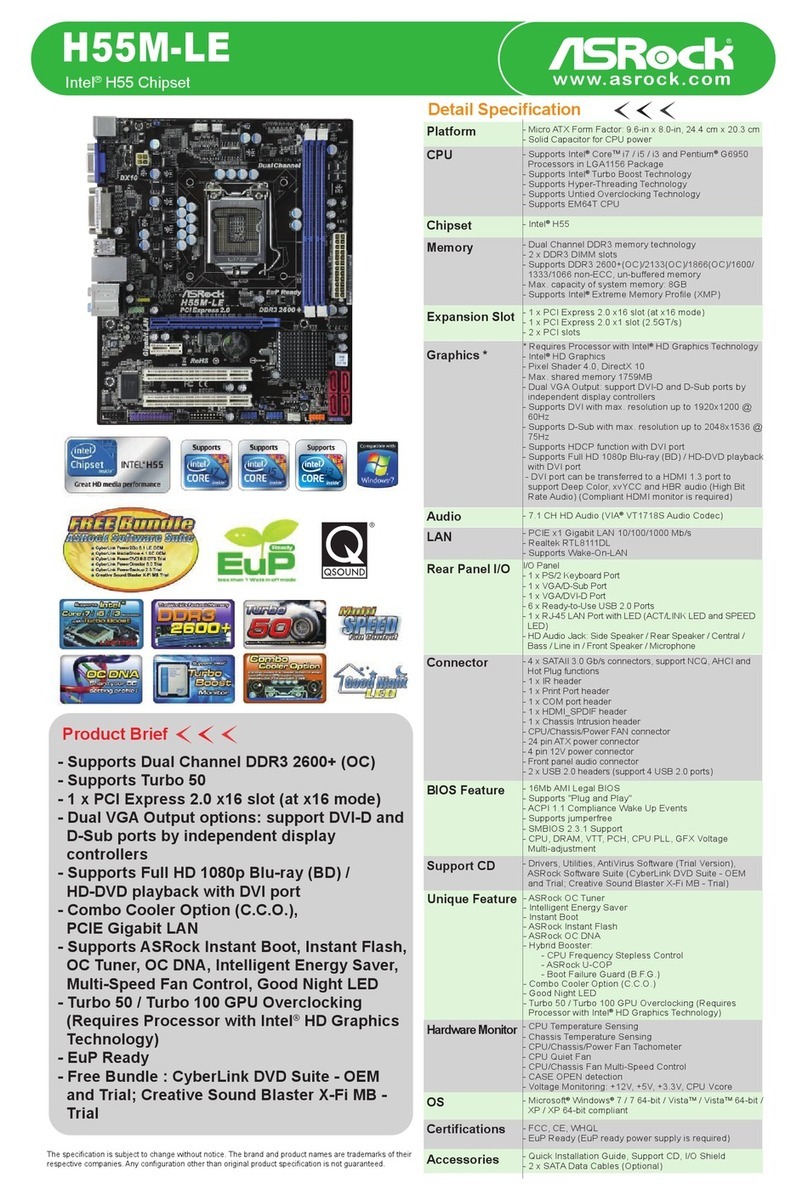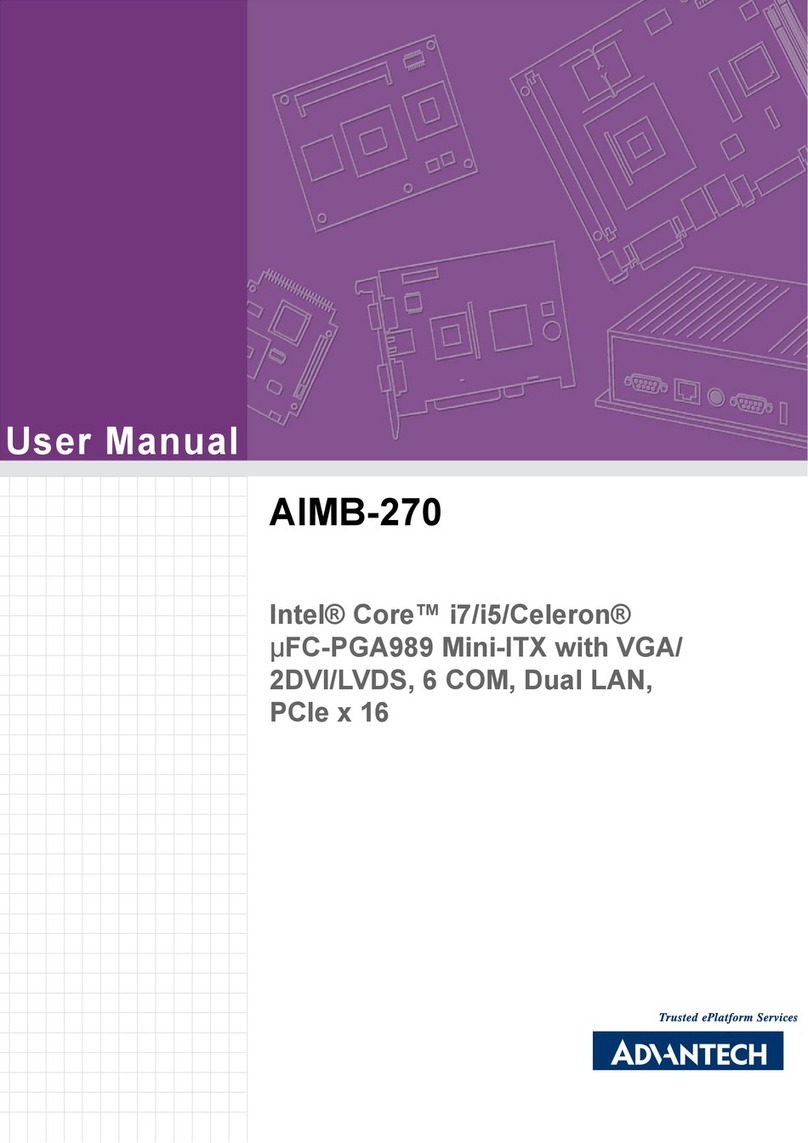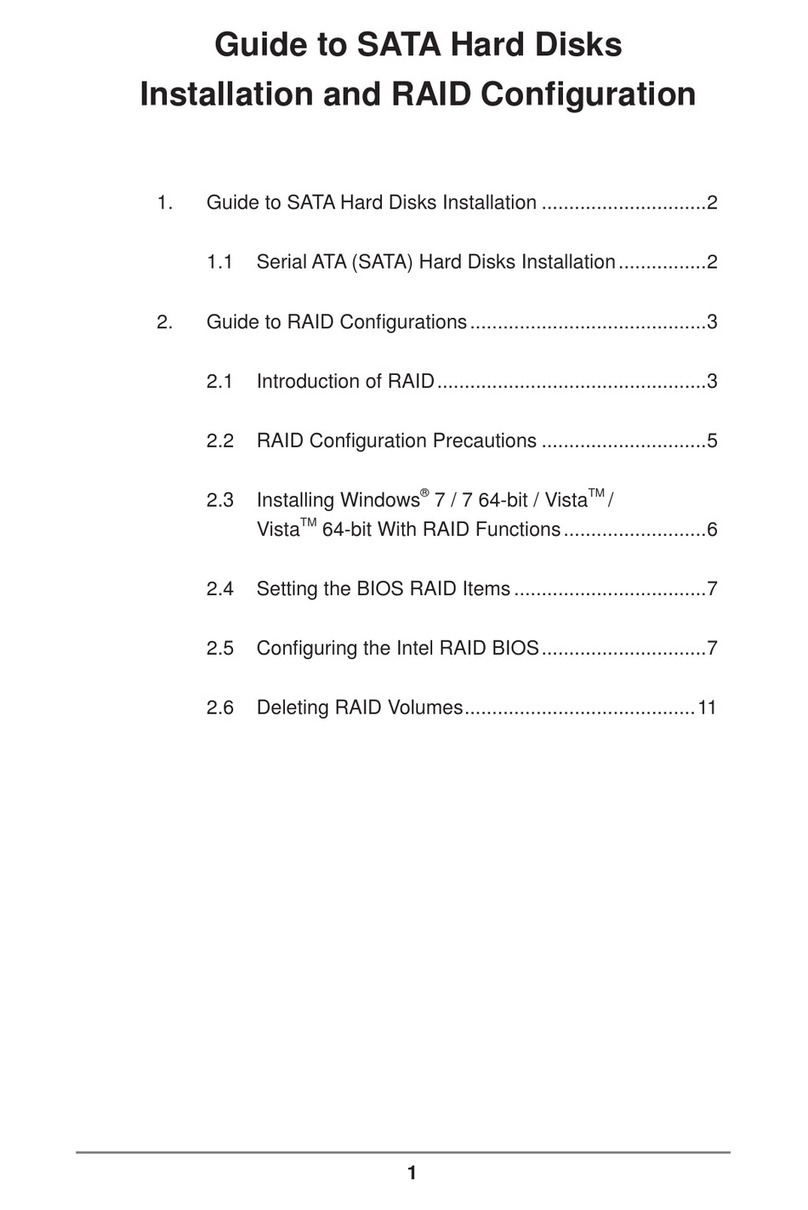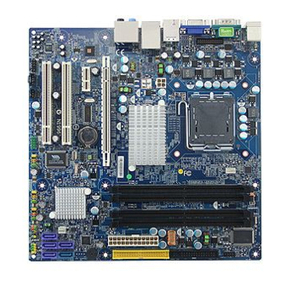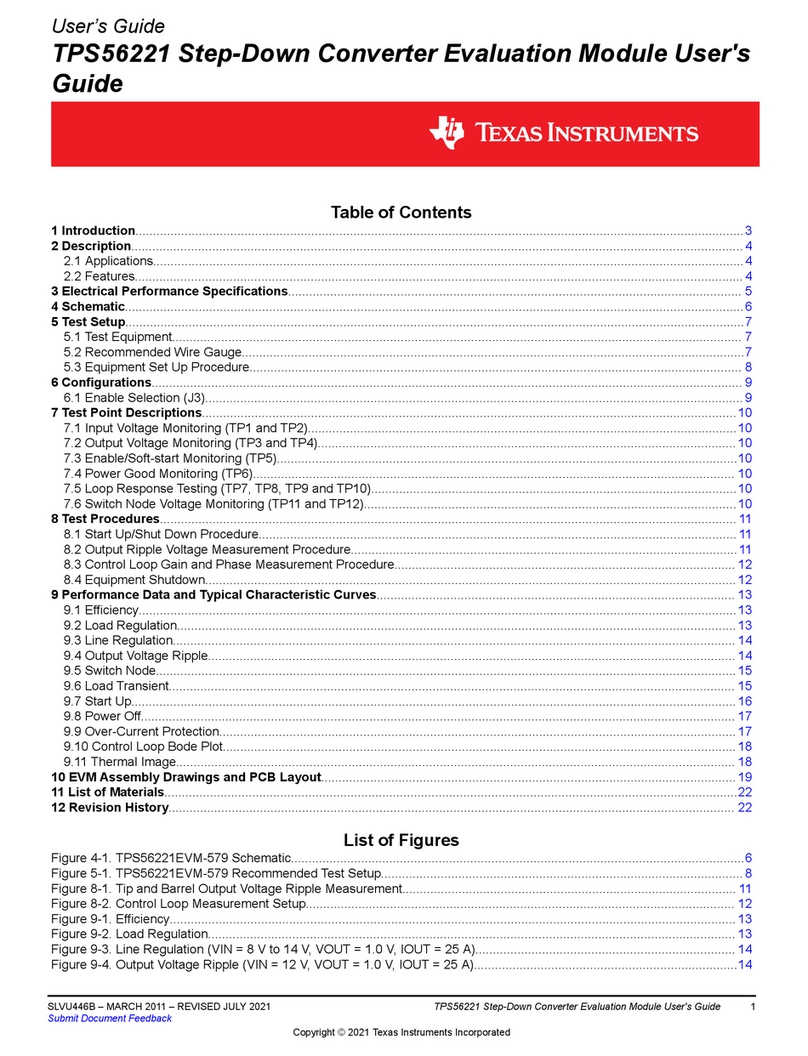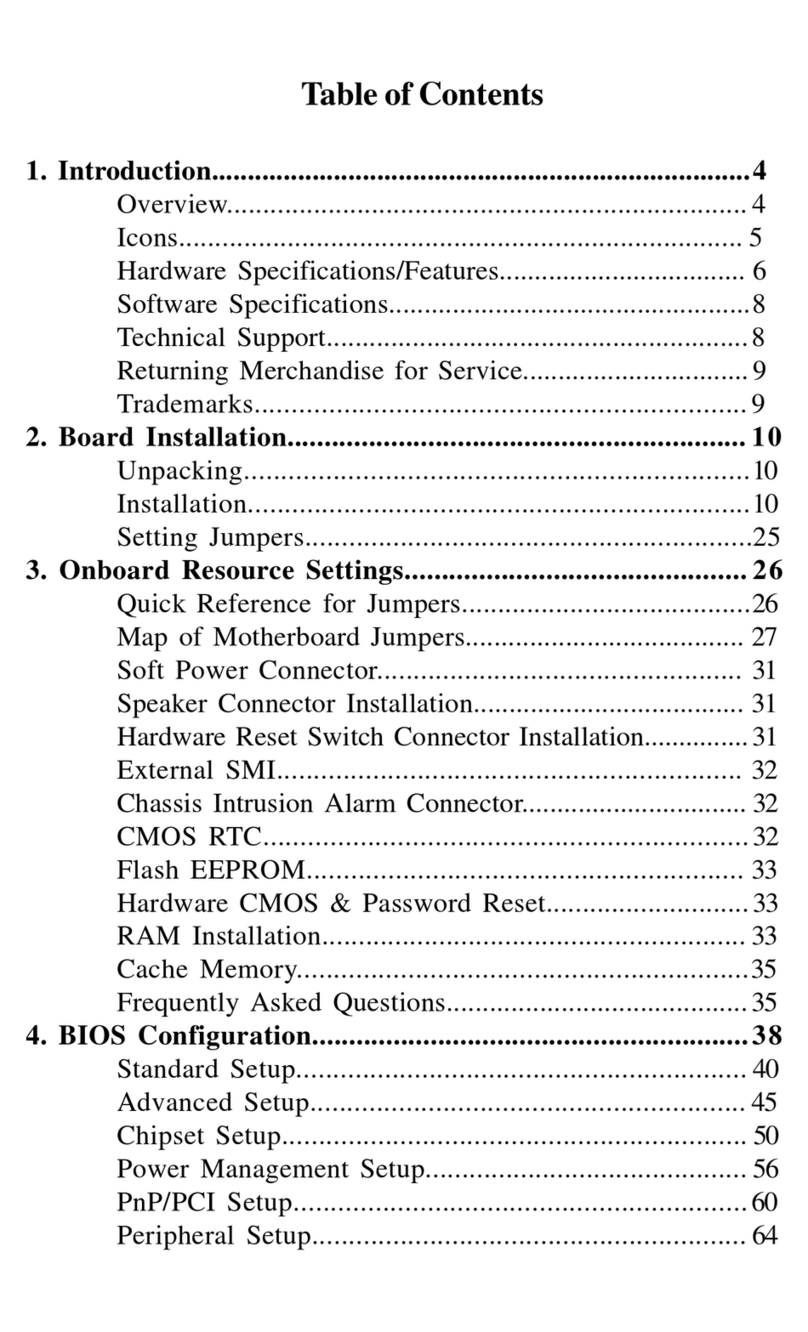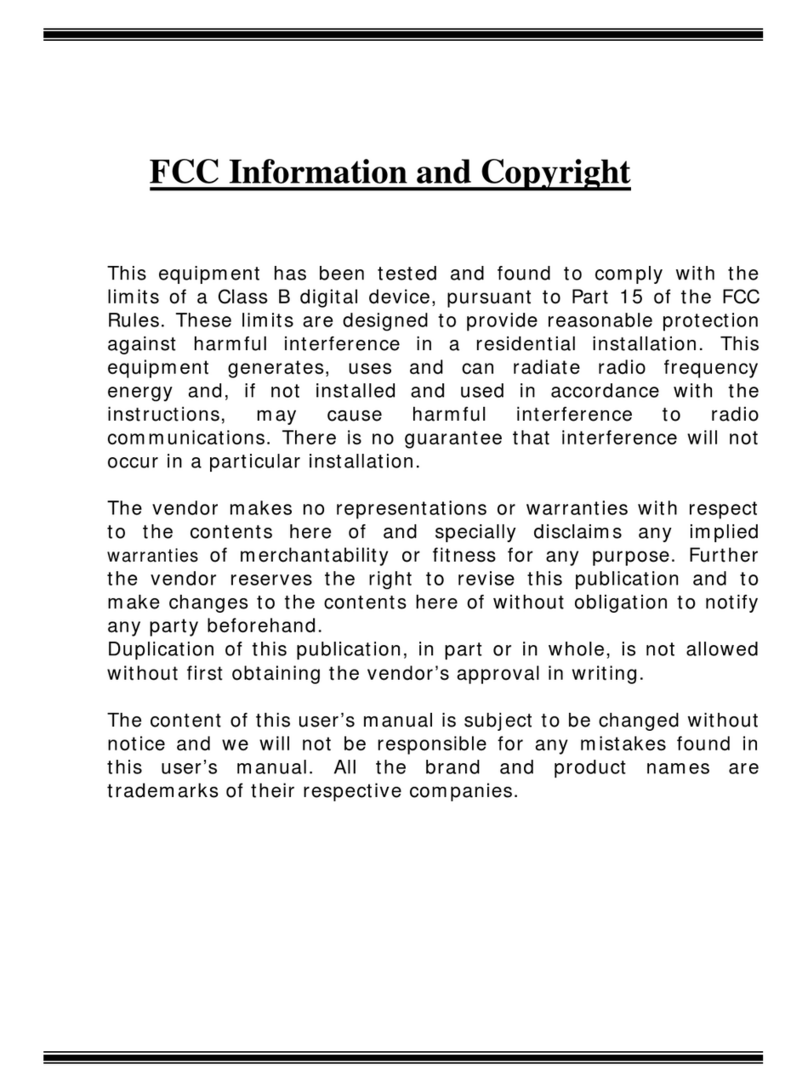Dataman S4 User manual

DATAMAN S4 MANUAL
Introduction to S4 1
Introduction to S4
DATAMAN S4 is a battery-powered PROM
programmer for Microsystem Designers. It
can readily be used for production
programming too.S4 contains 128k, 256k or
512k of RAM which retains data and
configuration even when switched off. The
RAM can be downloaded with data and
manipulated either remotely from a computer
via RS232 interface or directly from S4's
keypad. S4 provides plug-in emulation for
PROMS via a 24/28/32 pin emulator lead. The
development method is that a new program
can tried out by emulation. When it works, a
PROM can be programmed, plugged into the
system and the job is done. Programming
facilities include EPROMS of the 27 series,
such as 2716 or 278000, also FLASH
EPROMS and most EEPROMS, including 28,
52, 55 & 98 series.

DATAMAN S4 MANUAL
2Introduction to S4
Other devices can be programmed, such as
single-chip microprocessors, but some require
a plug-in adaptor.
Check List of Parts and Accessories
1. Dataman S4 .
2. Manual (you are reading it).
3. Write Lead 2mm plug to Minihook.
4. EMULead - Ribbon cable with 32 pin DIL
plug.
5. LIBRARY ROM.
6. Disk with Terminal Driver Program and
Utilities
7. Mains charger.
Three Year Guarantee.
S4 has a back-to-base guarantee to the
original purchaser for three years from date of
purchase. All electronic parts and labour are
covered, except the batteries which are only
covered for the first year. To make a claim,
first telephone us with details of the fault.
Some problems can be fixed quickly without
any need for us to see the product. You can
fit new batteries yourself, for example. If we
need to see it, we will give you a return-
number: then you should send the product
back to us directly, quoting that number.
Sending it to a dealer usually wastes time. We
aimto return repairs in less than two working
days. It helps if you include a written
description of the fault. If the product
develops a fault when it is out of guarantee
then there is a fixed repair charge. At time of
writing it is £75 plus carriage.

DATAMAN S4 MANUAL
Introduction to S4 3
Confirming that S4 works
Switch on and rotate the display thumb-wheel
away from you to its full extent, which darkens the
display. Adjust for best contrast, which depends
on viewing-angle and temperature.If a LIBRARY
program is loaded, S4 will display the version
number:
DATAMAN S4 LIB 1.1
128K BYTES RAM
>
If you see this message then you may carry on and
use S4. Store the LIBRARY ROM somewhere
safe, in a piece of conductive foam. If there is
nothing in the display turn up the contrast by
rotating the thumbwheel on the left of the display
away from you to its fullest extent. If still nothing,
perhaps the battery is totally discharged. Plug the
charger in with the RESET button depressed and
hold it in for a few seconds. When you release it
you will see a message:
DATAMAN S4 BIOS
1.1
128K BYTES RAM
NO LIBRARY LOADED
Loading the LIBRARY ROM
Reloading S4's software program from
LIBRARY ROM is not something you should
need to do to a brand new product. In fact
you should never need to do it at all, except
when a new version of the working program is

DATAMAN S4 MANUAL
4Introduction to S4
to be loaded. The procedure is as follows:
press the RESET button by pushing the write
lead plug through the hole in the case above
the ON/OFF switch. (No force is needed - it is
only a push button!) You will see this
message:
DATAMAN S4 BIOS
1.1
128K BYTES RAM
START LIBRARY?
You will notice that the version of LIBRARY is
not identified, because there is no LIBRARY
program loaded. If S4 sees what it thinks is a
valid library it will ask you if you want to run it.
ESC = NO
ENTER = YES.
If you do want to load a new library press ESC
then LIB . Put your LIBRARY ROM in the
socket and press ENTER S4 will load the
program contained in the LIBRARY ROM.
Then it will restart and run the program. If the
LIBRARY program loads correctly, S4 will
introduce it and display the version number.
When the RESET button is pressed, S4
returns to low-level BIOS MODE, in which it
will only program LIBRARY PROMS of the
27256 variety. It is not intended that you
should use S4 in BIOS MODE without a
library loaded.NB. In theory you will never
need to load the LIBRARY program. It will be
present in memory when you buy your S4 and
it will remain there, because S4's memory is
permanent and continuous for both programs
and data. The only reasons for loading a
LIBRARY are to upgrade to a new version or

DATAMAN S4 MANUAL
Introduction to S4 5
to reload your own custom version of the
library, with your preferred defaults, after
somebody else has used your S4 and
changed the settings.
RESET & BIOS Mode
If RESET is pressed S4 returns to a program
running in the masked ROM of the
microcontroller this is called the BIOS (Basic
Input/Output System). Whilst S4 will run in
this BIOS mode and obey most instructions, it
is not intended to be used without a LIBRARY
loaded into the TPA (Transient Program
Area). The BIOS contains subroutines which
are used to handle input and outputs - RS232,
Keyboard, Display etc. BIOS mode is used
only for development of new library
programs.In BIOS mode, S4 will only
program a 27256 EPROM, of the type used as
a LIBRARY ROM. This section is written for
sake of completeness - it is unlikely that
anyone not developing new software for S4
will want to use the BIOS mode.Whilst the
RESET key is down and the charger attached,
charge is forced into the battery. This gives a
"Jump Start" facility for batteries which are
absolutely flat.S4's microprocessor and RAM
have power on all the time. <$IPower-
up>When
S4 is switched on, it awakens from a SLEEP
MODE and starts operation
at the address pointed to by the Warm Start Vector
(WSV). Loading
and running a library reloads the WSV so that S4
starts operation
in the right place. Pressing RESET points the
WSV back into the BIOS

DATAMAN S4 MANUAL
6Introduction to S4
but it first looks at the TPA . If the program thinks
it sees a valid
library, it will ask you whether you want to run it:
DATAMAN S4 BIOS
1.1
128K BYTES RAM
START LIBRARY?
ESCape will do a COLD START into the BIOS.
ENTER will run the library.
If you want to reload your LIBRARY ROM, place
it in the ZIF socket
and press LIB.
<$IHELP ROM>The LIB key loads a program
into the Transient Program
Area from 8000 to FFFF, from a ROM in the ZIF
socket. The LIBRARY
ROM must be recognised by the system as a valid
library. A ROM which
does not contain a LIBRARY will not load. The
BIOS configures S4 to
handle a 27256, so the LIBRARY ROM must be a
27256.
<$IPower-down,
automatic>Automatic Power-down
If there is no charger connected, S4 goes to sleep
if there is no
input for 30 minutes. It turns the display off and
enters a powered-down
mode. For the last 30 seconds it makes beeping
noises. It will switch

DATAMAN S4 MANUAL
Introduction to S4 7
itself off at the end of this time. If you press a key
during the
beeping, power-down is prevented. No data is lost
by power-down,
but you have to switch-off-and-on-again to get the
power back.
If a charger is connected, S4 remains on. If the
battery runs down
to the 25% point, it is automatically recharged.
S4 also powers down when it believes that the
battery is getting too
low - less than 8.4 volts. At this level, data and
program can
be preserved, but nothing else works. It warns you
first, both audibly
and with a message. If the voltage goes below 8
volts it turns off
immediately without warning. S4 cannot do
anything useful without
power, except preserve the memory contents.<MI>
<BI>The only cure is to charge the battery.
Memory Upgrade to 512K
S4 user memory can be upgraded by changing the
1M static RAM chip
for a 4M part. The only suitable static RAM at
time of writing is
a Hitachi HM628512LP due for release 2nd
quarter 1992. If that is
not available then there is a 4M module
HM66205L. RAMS of any speed will
work, but faster parts improve access time for
emulation.
The upgrade procedure is simple.. First switch off
then:

DATAMAN S4 MANUAL
8Introduction to S4
@BULLET = 1) Remove the back of the case by
unscewing the four retaining
screws.
@BULLET = 2) Remove the 1M static RAM
chip from its socket.
@BULLET = 3) Substitute a 4M static RAM
chip or module.
@BULLET = 4) Replace the back of the case
and the screws.
When you switch on, S4 will now tell you that
you now have 512k of
memory instead of 128k.
<BI>It is anticipated that 4M chips will fall in
price. The upgrade
will be cheaper if you can wait for a few
months.<D>
<$ISocket, ZIF>The ZIF Socket
The ZIF (Zero-Insertion-Force) socket is used to
load new library
programs into the TPA (Transient Program Area)
as already described.
The ZIF socket is also used to hold PROMS when
programming. S4 can
use PROMS much the same as a computer uses a
disk-drive: they are
a permanent storage medium, which contains
programs to be loaded into
system RAM - such as the program loaded from
the <$IHELP ROM;Copying
to TPA>LIBRARY ROM.
<$IZIF socket>When the socket is not being
addressed, no power is
applied to it. PROMS can be inserted at any time,
except during an

DATAMAN S4 MANUAL
Introduction to S4 9
operation like LIB, LOAD, BURN, TEST, SUM or
COMP, which read the
PROM. When S4 is waiting for a command, or
performing any function
which does not involve reading a PROM, the
socket is "cold" - it
has no supply voltages. Even when the socket is
being addressed directly,
it is only powered-up for sufficient time to read the
data.<$IPROM;24
pin>
PROMS with 24 pins or 28 pins must be inserted
at the bottom end
of the socket - the upper pin-sockets of each side
should be empty.
<$IGlossary of terms>Terms and
Basic Concepts
<$IWYSIWYG><$IESC message>The message
ESC in the display means that
the ESC key was pressed during or before
execution; the previous command
was not completed or maybe not even started.
The ZIF means the Zero-Insertion-Force socket on
the front panel.
<$IKeypad repeating>The Keypad refers to S4's
45 keys. Key repeat
is automatic, when a key is held down. The delay
after the first
entry is longer than that after subsequent entries,
to prevent false
repetition. When data is being entered by
repetition, the flashing
block cursor changes to a steady underline cursor,
so that progress
is easier to follow.

DATAMAN S4 MANUAL
10 Introduction to S4
The Screen means the remote terminal screen.
The Display means either the terminal screen or
S4's liquid crystal.
The Keyboard refers to the remote terminal.
<$ILCD;Liquid Crystal Display>The LCD is S4's
own Liquid Crystal
Display. Outputs are shown boxed in the text,
meaning that this is
literally what you will see:
DATAMAN S4
512K BYTES RAM
NO LIBRARY LOADED
>
The Command Line means the display line which
starts with a prompt “>“ An operation will be
performed if you press ENTER or
be aborted if you press ESCape.
ESCape Commands which are non-destructive (do
not change anything)
are actioned as soon as you press the key, without
waiting for ENTER
A Digit is always Hexadecimal - not Decimal.
An Address defines one location in memory
(expressed as 5 digits).
A Parameter is a set of Digits, two for a Byte, five
for an
Address.
<$IBlocks;Explanation>A Block means
contiguous bytes of memory from Start
address to End address inclusive. If three
parameters appear the
last is the Destination address.

DATAMAN S4 MANUAL
Introduction to S4 11
<$ITerminal Editing>Backspace and space are
used to edit parameters
in the command line from the terminal keyboard,
equivalent to <F129M>
c <F255D>and <F129M>d<F255D> keys on the
keypad.
<$IKEY;ESC>ESC aborts a command, even if it
is already running. That
part of the command which is already done cannot
be undone, of course.
ENTER (or RETURN) accepts a command as
seen.
ESCape or ENTER may be pressed anywhere in
the command line. If
the parameters have been altered, ENTER accepts
them as seen but
ESCape restores the originals.
Where there are three parameters in the command
line they are in
the following order START, END,
DESTINATION. Each parameter is five
hex digits.
@COMPUTER TEXT = <R>
>><R>
>>LOAD 2764<R>
00000-01FFF=04000
The START and END addresses normally define
the whole PROM. They can
be edited to limit the effect of functions to less
than a whole PROM.
<$IParameter;Editing>When editing the START
address, if the<F129M> a <F255D>or<F129M>
b <F255D>keys are pressed, then the START and
END addresses will change
automatically to new boundaries.

DATAMAN S4 MANUAL
12 Introduction to S4
If the START address is changed to fall outside
the current boundary
then the END address changes automatically to
the end of the new boundary.
If either the START or the END address is moved
away from the boundary,
the = (equal) sign will change to a # (not equal).
S4 refuses to accept a value for the END address
outside the current
PROM size.
If the configured PROM is bigger than the
available memory, then the
sign before the DEST address will always be #. In
this case it is
not possible to handle the whole PROM in one
pass. The DEST address,
may be edited with the <F129M>a <F255D>and
<F129M>b<F255D> keys to divide the PROM
into blocks which can be handled separately.
@COMPUTER TEXT = >>BURN<R>
AMD/MMI 27C080<R>
12.75v TO PIN 1<R>
00000-1FFFF#40000
Only one set of START, END, DEST addresses
are stored and shared between
those functions which use these parameters.
Pressing the ESCape key when editing the
parameter line aborts the
command, but leaves the START, END, DEST as
seen - it does not restore
their original values.
<$IPROM;Page Mode>Paged
EPROMS e.g. 27513
A Page has a special meaning for EPROMS like
the 27513, which is

DATAMAN S4 MANUAL
Introduction to S4 13
divided into pages of 16K bytes. S4 handles page
mode EPROMS as if
they had straightforward contiguous memory.
Swapping pages is handled
"behind the scenes" without troubling the user.
Thus there is no apparent difference in the way S4
handles a 27512,
which is one single block of 64k bytes, and a
27513, which is 4 pages
of 16k bytes.
The user must be aware of the real difference,
however, and how it
affects his system. Use of these devices is
described in manufacturers'
literature.
FUNC Key
The FUNC key is used like a shift key to access an
extra set of functions.
When waiting for a function the prompt becomes
* instead of >>
<$IBeeper>Audible Tones
S4 makes a variety of beeping noises:
A single tone is made on acceptance of a key.
A double tone low-high is a rebuke that a key is
not acceptable.
During the execution of those commands which
take several seconds,
"pips" are emitted every half-second to tell you
that the program
is working - except in the BURN routine, which
writes addresses
to the display.
An incoming data-file makes a recognisable
sound.

DATAMAN S4 MANUAL
14<$IComputer Operation>Computer Operation<$&Computer>
The ADVANCED SETUP has variables which
can be modified to change the
tones made by the beeper. <$IComputer
Operation>Computer
Operation<$&Computer>
There are two ways of using S4. The obvious way
is to enter commands
by pressing keys and reading the 80-character
LCD. The other way is
to attach an <$IRS232;Remote operation>RS232
interface lead and enter
commands from your computer and see the results
on the screen. There
are differences between Stand-alone and Remote
operation, but each
key on S4's keypad has an equivalent two
character serial command. S4
always responds to the requesting device: keypad
commands produce
responses in the LCD, computer commands
produce screen responses.
S4 will respond to either device from the
command prompt; no switching
of modes is necessary. <$IRS232;Connection and
disconnection>If you
disconnect the RS232 interface during a command
it may be necessary
to switch-off-and-on-again to regain control at the
keypad.
Once a function has been entered from either the
computer interface

DATAMAN S4 MANUAL
<$IComputer Operation>Computer
Operation<$&Computer> 15
or the keypad, the other device is ignored., until
S4 returns to the
command prompt >>.
Interfacing with a Computer.
Almost every S4 user will need to make a serial
link with a computer
at some time. Computers usually have a serial
port, through which
file transfers can be made, in much the same way
as files can be transferred
between disks. In fact the operating system file-
copying routines
can specify the serial device: MSDOS uses
COM1: or AUX:, CP/M refers
to RDR: and PUN: for example the command to
transfer a file to S4
from an IBM-type PC is:
@COMPUTER TEXT = COPY FILE.HEX
COM1:
The baud-rate, word-length, stop-bits and parity
setting must have
been set previously to the correct values. The
command to do this
is:
@COMPUTER TEXT = MODE
COM1:9600,N,8,1
S4 must be set similarly, and the file-format must
expect, in this
case, an Intel HEX file which is decoded as it is
received. Downloading
files from the operating system is likely to work
with no handshaking
problems, because S4 will receive any file at full
speed.

DATAMAN S4 MANUAL
16<$IComputer Operation>Computer Operation<$&Computer>
Sending files back is often not so easy. Computers
seem to implement
handshaking properly on output, but not on input.
It is surprisingly
difficult to get any information on this subject: the
manufacturer's
data tells you the names of the signals, but does
not tell you that
they do not work. Experiments show that the input
buffer overflows
at some point, usually at 64K, when the system
transfers the buffer
contents to disk. 64K characters is not 64K bytes,
because a HEX
file contains two ASCII characters for every data
byte plus addresses,
checksums and other odds and ends. In fact it is
more like 26K bytes. For
small PROMS this is enough. It is possible to
send the whole 64K
as 3 chunks, then patch it together with a word-
processor and take
out the two spurious End-of-File lines. A much
better solution is
to use some kind of COMMS or TERMINAL
program.
Terminal Emulating Programs.
A TERMINAL sends the information you type at
the keyboard through
the serial port. It displays what comes back
through serial port
on your screen. When S4 is connected to your
computer running a terminal
program, it might seem that what you type appears
on your screen:

DATAMAN S4 MANUAL
<$IComputer Operation>Computer
Operation<$&Computer> 17
that is not so. What your see is what S4 chooses to
send you in response:sometimes
this is what you typed: sometimes it is not.
Terminal programs usually
let you send and receive files as well, with
handshaking properly
implemented, and that is all that is required for
complete control
of S4.
S4DRIVER.
Dataman supplies free terminal software for your
PC for use with S4.
S4DRIVER has online help and will work at
speeds up to 115200 baud.
File Formats.
S4 sends and receives orthodox computer files.
Only a programmer with an unusual amount of
patience would wish to
enter a large quantity of code into S4 by keying it
in hexadecimal
numbers. Microsystems have in the past been
developed by "hand-assembly":
the translation of microprocessor instructions into
machine code mentally
without benefit of an assembler, writing the
instructions into memory
in hexadecimal using a keyboard and repetitively
trying out the program
until it works. Most sane programmers these days,
who want to stay
sane, would use an assembler which permits the
entry of code as instruction-mnemonics. The

DATAMAN S4 MANUAL
18 Bulletin Board
assembler creates a file of machine-code
automatically, but the file
is not usually actionable code. Actionable object
code which is placed
in memory exactly as it is received is called
BINARY format. Transmission
formats usually have a certain amount of extra
information, for example
the ADDRESS to start loading the data,
CHECKSUM bytes to validate
transmission etc. S4 receives files in common
formats which are output
by assemblers; formats such as INTELHEX,
MOTOROLA S, TEKHEX, ASCII
or BINARY and translates these into actionable
object code which is
stored in the USER RAM.
Bulletin Board
Dataman runs a 24 hour Bulletin Board
Service.
The BBS contains software updates for
Dataman products, including S3, S4 and
Omni-Pro. There are also useful utilities for
downloading.
Dataman welcomes all uploads to the system
and encourages discussion about our
products, suggestions for improvements,
complaints and items of general interest to
other users.
The BBS supports the following speeds
300(V21) 1200(V22) 2400(V22bis) 9600(V32)
14400(HST) with MNP error correction up to
level 4, V42 error correction and V42bis

DATAMAN S4 MANUAL
Bulletin Board 19
data compression.
How to LOG ON:
Set your terminal program to the appropriate
baud rate and protocols.
Dial the BBS number 01300-321095.
If your modem speaker is turned on, you
should hear tones. Shortly afterwards a
CONNECT message should appear. The
BBS should then introduce itself:
Connected at 2400 Bits Per Second.
You are connected to the Dataman
Bulletin Board
[C]ontinue, [S]top, [N]onStop:
When RETURN is pressed the following
question will appear:
What is your First Name?
You should then enter your first name and press
RETURN.
@BULLET = What is you Last Name?
You should now enter your last name and press
RETURN. If this is
your first time on the system you will be asked:
@BULLET = The name [name] was not found in
the user database.
@BULLET = Is this name spelt correctly?
If the name is not correct, then press N and
RETURN. You will get two
more chances to enter your name correctly. If Y is
entered, the system
will log you on as a new user. You will be asked
several questions, such
as where you are calling from.

DATAMAN S4 MANUAL
20 Getting Started Quickly
If you have a problem with BBS:
Once on-line, during normal office hours, if you
are stuck, lost or
cannot locate a file, go to the Main Menu and
press P to page the
SysOp. The SysOp will then give you assistance,
on screen.
Getting Started Quickly
A guide for those who do not want to read the
manual.
Copying an PROM
If you want to make copies of a master PROM into
blank PROMS of the
same type, you must go through four stages:
@BULLET = 1) Configure S4 for the PROM
type
@BULLET = 2) Load the MASTER PROM
into S4.
@BULLET = 3) Test that the new PROMS are
blank.
@BULLET = 4) Burn the new PROMS
Configuring a PROM.
@BULLET = 1) Place the MASTER PROM in
the socket with the notch at
the top. If it has less pins than the socket make
sure that it is
at the bottom.
@BULLET = 2) Press PROM. Choose the
manufacturer with the <F129M>a
<F255>and<F129>
b<F255D> keys. Then choose the right part
number with the <F129M>c<F255D> and
Table of contents
Other Dataman Motherboard manuals
Popular Motherboard manuals by other brands

Atmel
Atmel AT89STK-06 CAN Software demonstration guide

Emerson
Emerson MVME4100 Installation and use

Asus
Asus P5GD2 PREMIUM installation guide
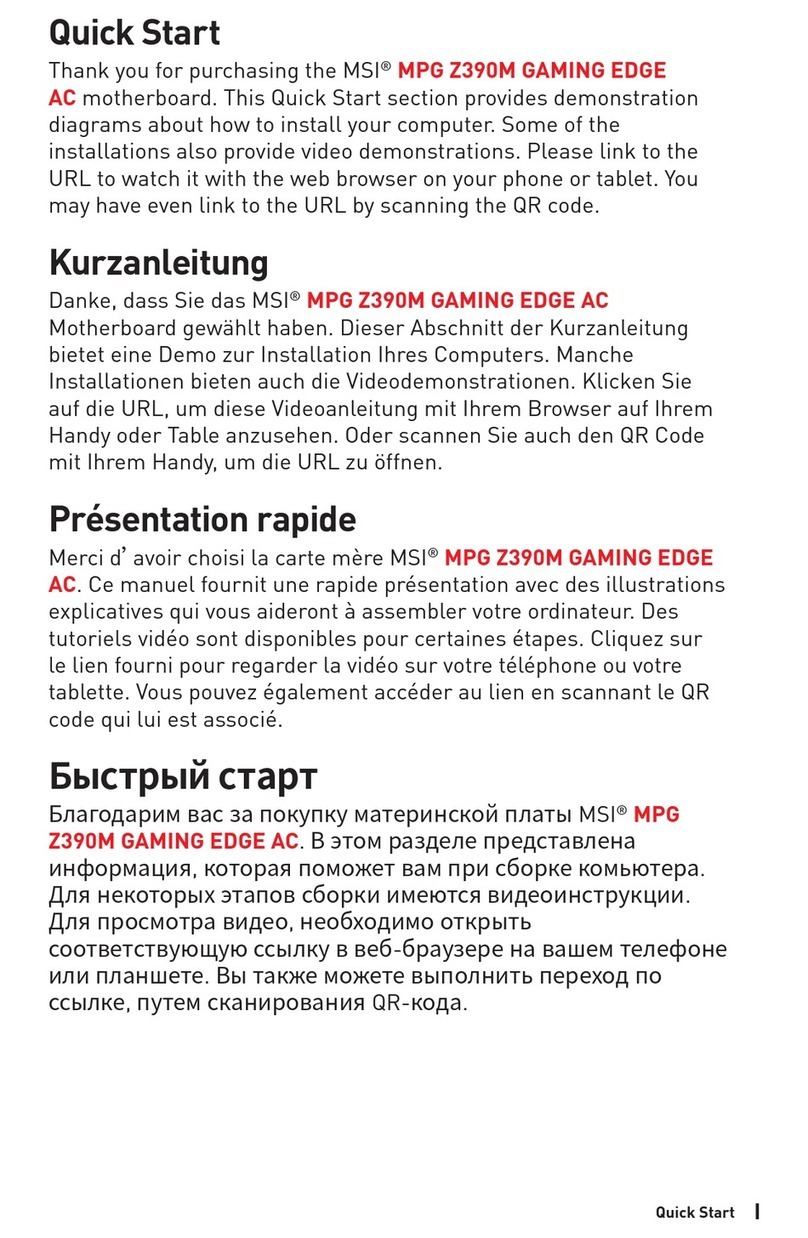
MSI
MSI MPG Z390M GAMING EDGE AC quick start
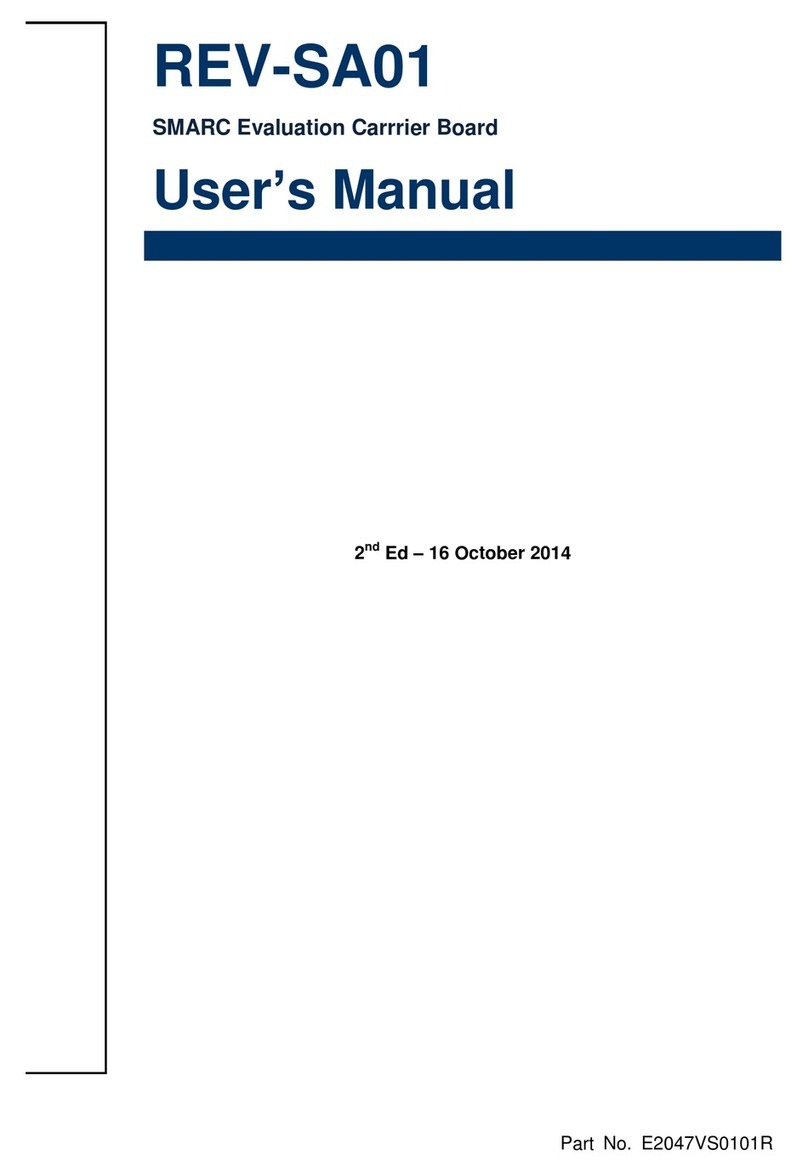
Avalue Technology
Avalue Technology REV-SA01 user manual
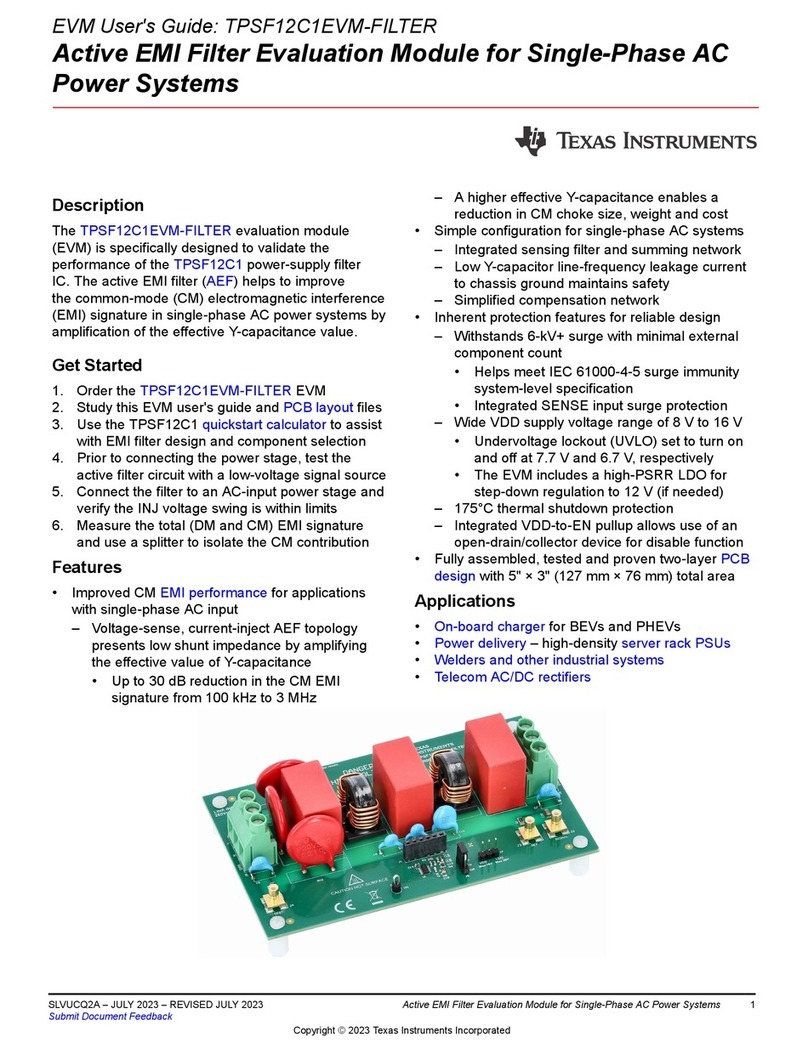
Texas Instruments
Texas Instruments TPSF12C1EVM-FILTER user guide
